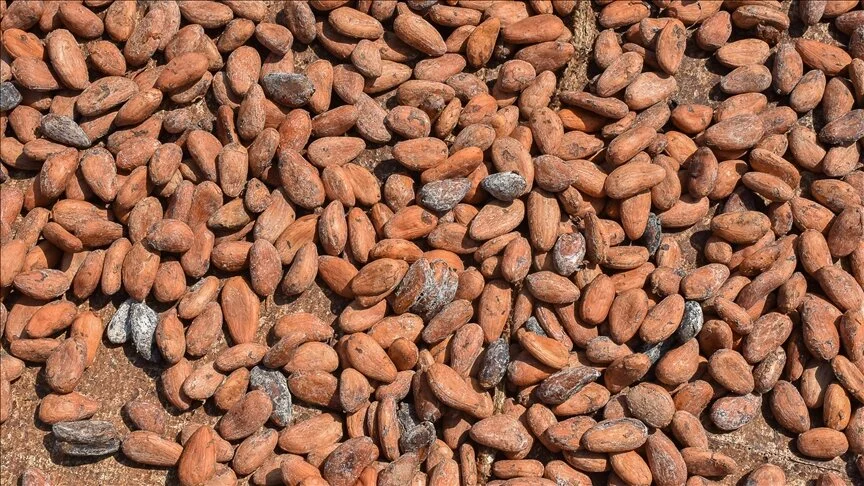BERLIN
Cocoa prices have nearly doubled in three months to record highs, influenced by the decline in global supply.
Prices hit a historic high as weather conditions in West Africa put chocolate producers in a difficult position, with the price per ton for May-dated cocoa traded on the New York Mercantile Exchange reaching an all-time high of more than $9,600.
Cocoa supply is estimated to fall 8% in the 2023 – 2024 season compared to the previous 12 months, with the main reason for the losses cited as problems in the Ivory Coast and Ghana, according to data analytics and consulting firm, GlobalData.
Prices continued to reach new peaks as major cocoa mills in the Ivory Coast and Ghana decided to cut or halt production as they could not cover seed costs.
A significantly lower cocoa harvest is expected in the Ivory Coast.
The Ivory Coast accounts for 45% of the global cocoa supply, however, harvests in other cocoa-producing countries, such as Nigeria and Ghana, are also well below expectations.
The intermediate harvest, which starts in April, is also expected to be lower than last year due to heat and drought affecting the development of cocoa beans.
Cocoa bean prices hit all-time highs Monday on the New York and London cocoa futures markets, as limited supplies and skyrocketing prices caused uncertainty.
Prices rose more than 150% in New York in the last three months, and since March 2023, have climbed 255%.
Cocoa hiked more than 61% last year and became the highest rising raw material, right after uranium, and surpassing copper, which was at $9,000 per ton in 2024.
Drought, heavy rain lead to reduced harvest
Unfavorable weather conditions, such as prolonged drought and heavy rain, are cited as the main cause of cocoa supply problems, while plant diseases also affect the crop.
In particular, the cocoa swollen shoot virus disease (CSSVD), which causes the death of cocoa trees, was among the leading factors negatively affecting cocoa production.
Trees affected by the virus have to be cut down, while newly planted trees take three to five years to bear cocoa, therefore, supply in the next two to three years is likely to be lower than the average for the last 15 – 20 years, leading to above-average prices for cocoa beans.
The market condition is called “backwardation,” which is when spot prices trade at higher levels than futures, and it indicates a supply shortage.
Sad news for chocolate lovers
Chocolate prices are expected to rise sharply around the world following the news from the Ivory Coast and Ghana, which make up 60% of global cocoa production.
Surging cocoa prices signal a challenging period for consumers, as chocolate producers are passing on higher cocoa prices to consumers through price increases or reducing package sizes.
The decline in cocoa harvest due to weather conditions pushed chocolate producers to raise prices, and it is estimated that chocolate prices may increase more sharply with the continuation of the production cut.
Cocoa farmers have yet to benefit from record prices, while child labor still exists
Impoverished cocoa farmers in the Ivory Coast and Ghana have yet to benefit from record prices, as public sales companies in both countries sold more than half of the harvest, which began in October, in the spring of 2023, at half of today’s prices.
Besides, in both countries, 43% of the children aged 5 to 17 are affected by child labor in cocoa production, which makes up about 1.5 million children.
Prolonged rains cause infestation of cocoa trees, says expert
Zafer Ergezen, a futures and commodity markets expert, told Anadolu that cocoa prices rose quite rapidly, especially in the last year.
He cited adverse weather conditions in West Africa as one of the biggest reasons for the surge in prices.
“El Nino weather phenomenon caused temperatures to be warmer and rain to be wetter than before,” he said. “The cocoa produced in West Africa, mainly in countries, such as Ghana, the Ivory Coast, and Nigeria, is the main source of the world’s chocolate industry, and while temperatures in the region were expected to be warm, prolonged rains caused insect infestation of cocoa trees.”
Cocoa yields also on decline
Ergezen said insect infestation of cocoa trees led to a decrease in yields, and now the rainfall and temperatures in the region caused a serious supply shortage in the sector, as stocks fall rapidly.
“When we entered 2024, we expected the effect of the change in weather conditions to decrease, though the adverse weather persisted, therefore, prices started to go up suddenly,” he said.
Ergezen noted that the production deficit hiked about four times compared to the previous period.
“When the production deficit is so high, prices will inevitably rise, which, in this case, may lead to chocolate packages shrinking in size, rather than going up in price, which has already been seen in the products of some producers in Europe,” said Ergezen.
He said it is difficult to pinpoint how long the situation will persist, though he will closely monitor the production estimate reports from the region.
“Access to the region is not easy and the reports on the issue are relatively limited, which hinders predictability,” he added.

